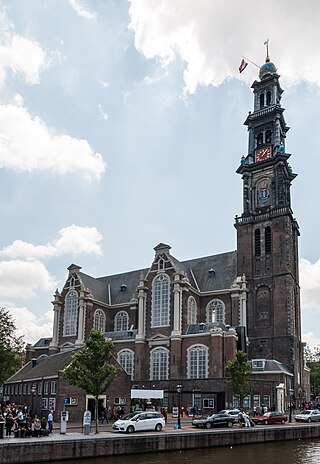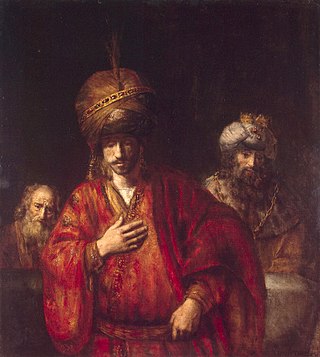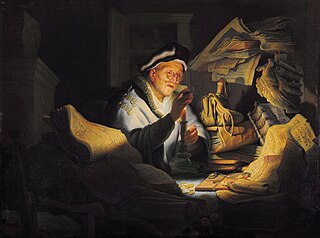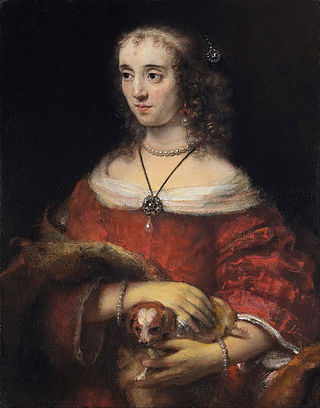
The Westerkerk is a Reformed church within Dutch Protestant Calvinism in central Amsterdam, Netherlands. It lies in the most western part of the Grachtengordel neighborhood, next to the Jordaan, between the Prinsengracht and Keizersgracht.

Saskia van Uylenburgh was the wife of painter Rembrandt van Rijn. In the course of her life, she was his model for some of his paintings, drawings and etchings. She was the daughter of Rombertus Uylenburg, the mayor as well as the justice of the Court of Friesland.

Rembrandt Harmenszoon van Rijn, usually simply known as Rembrandt, was a Dutch Golden Age painter, printmaker, and draughtsman. An innovative and prolific master in three media, he is generally considered one of the greatest visual artists in the history of art. It is estimated Rembrandt produced a total of about three hundred paintings, three hundred etchings, and two thousand drawings.

Titus van Rijn was the fourth and only surviving child of Rembrandt Harmenszoon van Rijn and Saskia van Uylenburgh. Titus is best known as a figure or model in his father's paintings and studies but also because of a legal case as preferential heir.

The Sampling Officials, also called Syndics of the Drapers’ Guild, is a 1662 oil painting by Rembrandt. It is currently owned by the Rijksmuseum in Amsterdam. It has been described as his "last great collective portrait".

Jos Stelling is a Dutch film director and screenwriter.

The Stoning of Saint Stephen is the first signed painting by Dutch artist Rembrandt, made in 1625 at the age of 19. one of his earlier works is an oil painting on a wood panel and currently exhibited at the Musée des Beaux-Arts de Lyon.

Self Portrait is an oil-on-canvas painting by the Dutch artist Rembrandt. Painted in 1652, it is one of more than 40 painted self-portraits by Rembrandt, and was the first he had painted since 1645. In composition it is different from his previous self-portraits, depicting the painter in a direct frontal pose, hands on his hips, and with an air of self-confidence. It was painted the year that his financial difficulties began, and breaks with the sumptuous finery he had worn in previous self-portraits. Art historian Christopher White has called it "one of the most magisterial and sombre of these (late) pictures". It is in the Kunsthistorisches Museum in Vienna.

Joseph and Potiphar's Wife is a 1634 etching by Rembrandt. It depicts a story from the Bible, wherein Potiphar's Wife attempts to seduce Joseph. It is signed and dated "Rembrandt f. 1634", and exists in two states.

The dozens of self-portraits by Rembrandt were an important part of his oeuvre. Rembrandt created approaching one hundred self-portraits including over forty paintings, thirty-one etchings and about seven drawings; some remain uncertain as to the identity of either the subject or the artist, or the definition of a portrait.

Self-Portrait at the Age of 63 is a self-portrait by the Dutch artist Rembrandt. One of three dating to 1669, it was one of the last in his series of around 80 self-portraits, painted in the months before his death in October 1669. Despite the closeness of his death, and the concentration on his aging face, Rembrandt makes an impression of a self-assured and confident artist. It was bought by the National Gallery, London in 1851.

Slaughtered Ox, also known as Flayed Ox, Side of Beef, or Carcass of Beef, is a 1655 oil on beech panel still life painting by Rembrandt. It has been in the collection of the Louvre in Paris since 1857. A similar painting is in Kelvingrove Art Gallery and Museum, Glasgow, possibly not created by Rembrandt himself but probably by one of his pupils, perhaps Carel Fabritius. Other similar paintings by Rembrandt or more likely his circle are held by museums in Budapest and Philadelphia.

The Portrait of Dirck van Os is a later painting by Rembrandt (1606–1669), created circa 1658. It is currently in the permanent collection of the Joslyn Art Museum in Omaha, Nebraska.

The Senses is a series of five oil paintings, completed c. 1624 or 1625 by Rembrandt, depicting the five senses. The whereabouts of one, representing the sense of taste, is unknown. Another, representing smell, was only re-identified in 2015.
Laurens van Rooyen is a Dutch pianist and composer. He is known for his cooperation in the theater with Herman van Veen. He composed many pieces for the piano and wrote the score for several Dutch films. He wrote two books on his experiences as a musician.

David and Uriah is a late, oil-on-canvas painting by Rembrandt, dated to around 1665 by the Hermitage Museum or c. 1666–1669 in the 2015 Late Rembrandt exhibition at the Rijksmuseum. It shows the moment when David sends Uriah the Hittite to the frontline of the war with the Ammonites so that David can sleep with Uriah's wife Bathsheba. Uriah is identified as the foreground figure, with David and Nathan in the background. It was first given this title by Abraham Bredius in his catalogue of Rembrandt's work – this has been supported by several other scholars from 1950 onwards, including in a 1965 study by Madlyn Kahr.

The Parable of the Rich Fool, also known as The Money Changer, is an oil painting on canvas of 1627 by Rembrandt, now in the Gemäldegalerie, Berlin. Produced early in the artist's career, it depicts the eponymous Biblical parable. The model for the figure is said to have been Rembrandt's father.

Pallas Athena is a c. 1657 oil-on-canvas painting by Rembrandt that belongs to the collection of Calouste Gulbenkian Museum in Lisbon.

Young Woman with a Lapdog is a c. 1665 oil-on-canvas painting of an unknown young woman by Rembrandt. It is now in the Art Gallery of Ontario, to which it was bequeathed in 1955 by the philanthropist Frank Porter Wood. It was previously identified as Rembrandt's daughter-in-law Magdalena van Loo (1641–1669), but the subject is now held to be unknown.

The Preacher Eleazar Swalmius is a 1637 oil-on-canvas painting by the Dutch artist Rembrandt. It is currently owned by the Royal Museum of Fine Arts in Antwerp. The painting has been certified a real Rembrandt. The painting was listed in 1727 in the catalog of the Duke of Orléans collection, as a portrait of an Amsterdam mayor by Rembrandt. It remained in the noble family's possession until 1792, when Duke Louis-Philippe-Joseph sold the entire collection to finance his political career and pay off debts. The painting passed through several English collections into the hands of the Bourgeois brothers, art dealers from Cologne, who sold the painting as an original Rembrandt to the museum in 1886. The painting was stored away for a long time due to doubts cast over its authenticity.


















